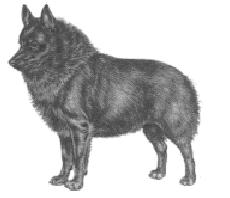Schipperke
General Information - Schipperke

Group:
Non
sporting
Size:
small
Lifespan:
13-15 years
Exercise:
medium
Grooming:
low
Trainability:
high
Watchdog ability:
very high
Protection ability:
high
Area of Origin:
Belgium
Date of Origin:
1600's
Other Names:
none
Original Function:
Barge dog, watchdog,
ratter
History
The Schipperke, which has been around in Flanders, Belgium for about 200 years, has an uncertain background. Some claim the breed descends from an ancient breed of black Belgian Sheepdogs; others suggest it is a member of the Spitz family; and some argue that it was a cross between a terrier-type breed and the German Pomeranian. Regardless of its ancestry, the breed has been used through the centuries as a barge dog, carriage dog, guard dog, and ratter. The man responsible for the development and standardisation of the breed in Belgium throughout the late 1800's was a Mr. Ruessens. Soon afterwards, it was imported to North America, Australia and England where it continued to grow in favour. Its most popular role today is that of family companion.
Temperament
Schipperkes love their families and will always be protective of them. This alert, curious and intelligent breed loves children and tends to bond very closely with their master. The Schipperke is a big dog trapped in a small dog's body. They are self-confident and will play with any dog of any size. Schipperkes love to howl and bark and make excellent watchdogs, standing their ground no matter what. Schipperkes make excellent boat dogs.
Upkeep
The active nature of this breed makes exercise - mental and physical - imperative. Its small stature makes getting that exercise fairly easy, however. Either a vigorous game in the yard or a moderate walk on leash will usually suffice to meets its needs. The Schipperke should not live outdoors, even though it enjoys spending the day in the yard. Its double coat needs weekly brushing, more when shedding.
Schipperke
A breed standard is the guideline which describes the ideal characteristics, temperament, and appearance of a breed and ensures that the breed is fit for function with soundness essential. Breeders and judges should at all times be careful to avoid obvious conditions and exaggerations, as well as being mindful of features which could be detrimental in any way to the health, welfare or soundness of this breed.
Breed Standard - Schipperke
 General Appearance:
General Appearance: A small cobby animal, with sharp expression, intensely lively, presenting the appearance of being always on the alert.
Characteristics: Intelligent, lively and alert.
Head and Skull: Head foxy in type, skull not round, but fairly broad, flat and with little stop. The muzzle should be moderate in length, fine but not weak, should be well-filled out under the eyes. Nose black and small.
Eyes: Dark brown, small, more oval than round and not full; bright and full of expression.
Ears: Sharp, of moderate length, not too broad at the base, tapering to a point. Carried stiffly erect and strong enough not to be bent other than lengthways.
Mouth: Teeth strong and level.
Neck: Strong and full, rather short set, broad on the shoulders, and slightly arched.
Forequarters: Shoulders muscular and sloping. Legs perfectly straight, well under the body, with bone in proportion to the body.
Body: Chest broad and deep in brisket. Back short, straight and strong. Loins powerful, well drawn up from brisket.
Hindquarters: Fine compared to the foreparts, muscular and well-developed thighs;
Tail: less rump well rounded. Legs strong, muscular, hocks well let down.
Feet: Should be small, cat:like, and standing well on the toes.
Tail: Customarily docked.
Coat: Abundant, dense and harsh, smooth on the head, ears and legs, lying close on the back and sides, but erect and thick round the neck, forming a mane and frill and with a good cullotte on the back of the thighs.
Colour: Should be black but other whole colours are permissible.
Weight and Size: Weight about 5.4 to 7.3 kg (12:16 lbs).
Faults:
- Drop or semi-erect ears
- Dudley noses in the coloured variety.
- A light-coloured eye.
- Head narrow and elongated, or too short.
- Coat sparse, wavy or silky.
- Absence of the mane and “cullotte”.
- Coat too long, and white spots.
- Undershot or overshot mouth.
Note: Male animals should have two apparently normal testicles fully descended into the scrotum.
DNZ No 784
Copyright Dogs New Zealand
19 Dec 2013
Any departure from the foregoing points should be considered a fault and the seriousness with which the fault should be regarded should be in exact proportion to its degree and its effect upon the health and welfare of the dog and on the dog’s ability to perform its traditional work.




